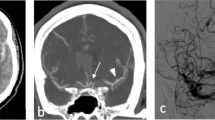Abstract
The purpose of this study was to evaluate the etiology of significant false-negative computed tomographic (CT) interpretations by radiology residents on-call. Over a 1-year period, significant on-call false-negative CT interpretations were analyzed to determine whether errors were perceptual (i.e., the resident did not see the finding or findings) or cognitive (i.e., the resident did not recognize the implications or misinterpreted a finding or findings). Significant “misses” were defined as errors that delayed surgical treatment or misdirected management in a potentially life-threatening manner.
A total of 12 significant false-negative interpretations occurred over a 1-year period. All head CT misses (extraaxial hemorrhage, pneumocephalus, contusion, subarachnoid hemorrhage due to ruptured aneurysm) were perceptual errors. Misses on thoracic, abdominal, and pelvic CT scans (2 abscesses, abdominal aortic aneurysm rupture, superior vena cava perforation due to catheter placement, ischemic bowel, liver laceration, hypoperfusion syndrome, appendicitis) were mixed (4 cognitive and 4 perceptual errors).
Since the diagnostic possibilities of emergency head CT scans are limited, residents missed only subtle, perceptual manifestations and had little difficulty interpreting findings when they were correctly recognized. The gamut of diagnostic possibilities in the thorax, abdomen, and pelvis was more challenging to residents on-call; errors in both perception and interpretation arose with equal frequency, and the significant error rate was higher than that for head CT interpretation. Junior residents, who make most of the significant on-call errors, commonly feel overwhelmed in attempting to assimilate the knowledge required to take call. Prepartion needs to be extensive, yet it should be focused on areas that will engender optimal impact on after-hours performance. When preparing residents to interpret on-call CT studies, perceptual manifestations of neuroradiology should be emphasized, whereas a more comprehensive approach to thoracic, abdominal, and pelvic disorders needs to be stressed.
Similar content being viewed by others
References
Rhea JT, Potsaid MS, Deluca SA. Errors of interpretation as elicited by a quality audit of an emergency radiology facility. Radiology 1979;132:277–80.
Mann FL, Danz PL. The night stalker effect: quality improvements with a dedicated night-call rotation. Invest Radiol 1993;28:92–6.
Roszler MH, McCarroll KA, Rashid T, Donovan KR, Kling GA. Resident interpretation of emergency computed tomographic scans. Invest Radiol 1991;4:374–6.
Seltzer SE, Hessel SJ, Herman PG, Swensson RG, Sheriff CR. Resident film interpretation and staff review. AJR Am J Roentgenol 1981;137:129–33.
References
Roszler MH. Radiology resident interpretation of emergency department radiographs. Emerg Radiol 1995;2:45–7.
West OC, Mann FA, Wilson AJ, Reinus WR. The “night stalker” effect: are quality improvements with a dedicated night call rotation sustained? Emerg Radiol 1994;1:236–41.
Author information
Authors and Affiliations
Rights and permissions
About this article
Cite this article
Funaki, B., Szymski, G.X. & Rosenblum, J.D. Significant on-call misses by radiology residents interpreting computed tomographic studies: Perception versus cognition. Emergency Radiology 4, 290–294 (1997). https://doi.org/10.1007/BF01461735
Issue Date:
DOI: https://doi.org/10.1007/BF01461735




